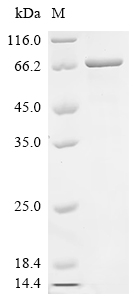Recombinant Human Forkhead box protein C1 (FOXC1)
CAT:
399-CSB-EP618640HU-03
Size:
1 mg
Price:
Ask
- Availability: 24/48H Stock Items & 2 to 6 Weeks non Stock Items.
- Dry Ice Shipment: No




Recombinant Human Forkhead box protein C1 (FOXC1)
- CAS Number: 9000-83-3
- Gene Name: FOXC1
- UniProt: Q12948
- Expression Region: 1-553aa
- Organism: Homo sapiens
- Target Sequence: MQARYSVSSPNSLGVVPYLGGEQSYYRAAAAAAGGGYTAMPAPMSVYSHPAHAEQYPGGMARAYGPYTPQPQPKDMVKPPYSYIALITMAIQNAPDKKITLNGIYQFIMDRFPFYRDNKQGWQNSIRHNLSLNECFVKVPRDDKKPGKGSYWTLDPDSYNMFENGSFLRRRRRFKKKDAVKDKEEKDRLHLKEPPPPGRQPPPAPPEQADGNAPGPQPPPVRIQDIKTENGTCPSPPQPLSPAAALGSGSAAAVPKIESPDSSSSSLSSGSSPPGSLPSARPLSLDGADSAPPPPAPSAPPPHHSQGFSVDNIMTSLRGSPQSAAAELSSGLLASAAASSRAGIAPPLALGAYSPGQSSLYSSPCSQTSSAGSSGGGGGGAGAAGGAGGAGTYHCNLQAMSLYAAGERGGHLQGAPGGAGGSAVDDPLPDYSLPPVTSSSSSSLSHGGGGGGGGGGQEAGHHPAAHQGRLTSWYLNQAGGDLGHLASAAAAAAAAGYPGQQQNFHSVREMFESQRIGLNNSPVNGNSSCQMAFPSSQSLYRTSGAFVYDCSKF
- Tag: N-terminal 6xHis-tagged
- Source: E.coli
- Field of Research: Epigenetics and Nuclear Signaling
- Assay Type: In Stock Protein
- Relevance: DNA-binding transcriptional factor that plays a role in a broad range of cellular and developmental processes such as eye, bones, cardiovascular, kidney and skin development. Acts either as a transcriptional activator or repressor. Binds to the consensus binding site 5'-[G/C][A/T]AAA[T/C]AA[A/C]-3' in promoter of target genes. Upon DNA-binding, promotes DNA bending. Acts as a transcriptional coactivator. Stimulates Indian hedgehog (Ihh)-induced target gene expression mediated by the transcription factor GLI2, and hence regulates endochondral ossification. Acts also as a transcriptional coregulator by increasing DNA-binding capacity of GLI2 in breast cancer cells. Regulates FOXO1 through binding to a conserved element, 5'-GTAAACAAA-3' in its promoter region, implicating FOXC1 as an important regulator of cell viability and resistance to oxidative stress in the eye. Cooperates with transcription factor FOXC2 in regulating expression of genes that maintain podocyte integrity. Promotes cell growth inhibition by stopping the cell cycle in the G1 phase through TGFB1-mediated signals. Involved in epithelial-mesenchymal transition (EMT) induction by increasing cell proliferation, migration and invasion. Involved in chemokine CXCL12-induced endothelial cell migration through the control of CXCR4 expression. Plays a role in the gene regulatory network essential for epidermal keratinocyte terminal differentiation. Essential developmental transcriptional factor required for mesoderm-derived tissues, such as the somites, skin, bone and cartilage. Positively regulates CXCL12 and stem cell factor expression in bone marrow mesenchymal progenitor cells, and hence plays a role in the development and maintenance of mesenchymal niches for haematopoietic stem and progenitor cells (HSPC). Plays a role in corneal transparency by preventing both blood vessel and lymphatic vessel growth during embryonic development in a VEGF-dependent manner. Involved in chemokine CXCL12-induced endothelial cell migration through the control of CXCR4 expression. May function as a tumor suppressor.
- Purity: Greater than 85% as determined by SDS-PAGE.
- Activity: Not Test
- Bioactivity: Not Test
- Length: Full Length
- Form: Liquid or Lyophilized powder
- Buffer: If the delivery form is liquid, the default storage buffer is Tris/PBS-based buffer, 5%-50% glycerol. If the delivery form is lyophilized powder, the buffer before lyophilization is Tris/PBS-based buffer, 6% Trehalose, pH 8.0.
- Reconstitution: We recommend that this vial be briefly centrifuged prior to opening to bring the contents to the bottom. Please reconstitute protein in deionized sterile water to a concentration of 0.1-1.0 mg/mL.We recommend to add 5-50% of glycerol (final concentration) and aliquot for long-term storage at -20℃/-80℃. Our default final concentration of glycerol is 50%. Customers could use it as reference.
- Molecular Weight: 62.8 kDa
- Storage Conditions: The shelf life is related to many factors, storage state, buffer ingredients, storage temperature and the stability of the protein itself. Generally, the shelf life of liquid form is 6 months at -20℃/-80℃. The shelf life of lyophilized form is 12 months at -20℃/-80℃.
